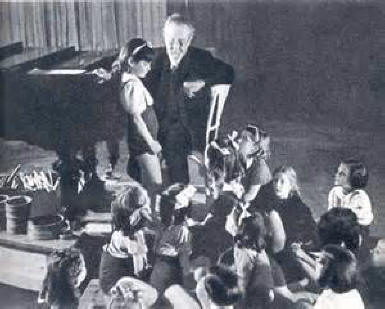Hansen, Kristen S., A Musical Game for Every Age-Group. Teaching Music, Vol. 9 Issue 1. EBSCOhost. UWEC McIntyre Library Eau Claire WI. Dec. 1 2006
Mead, Virginia Hoge, More than Mere Movement: Dalcroze Eurhythmics. Music Educators Journal Feb 1986 v72 n6 p42-46 ERIC EBSCOhost. UWEC McIntyre Library, Eau Claire, WI. 1 December 2006
Johnson, Monica Dale, Dalcroze Skills of All Teachers, Music Educators Journal. ERIC. EBSCOhost. UWEC McIntyre Library, Eau Claire, WI 1 December 2006
Zachopoulou, Evridiki, Vassiliki Drri, Dimitris Chatzopoulou, Theordoros Elinoudis. The Application of Orff and Dalcroze Activities in Preschool Children: Do They Affect the Level of Rhythmic Ability? Physical Educator; Spring2003, Vol. 60 Issue 2, p51, 7p. Academic Search Elite. EBSCOhost, UWEC McIntyre Library, Eau Claire WI 1 December 2006
DALCROZE EURYTHMICS In his own words . . .
It is not enough to teach children to interpret music with their fingers . . . the important thing is that the child should learn to feel music not only with his ear but with his whole being. To be completely musical, a child should possess an ensemble of physical and spiritual resources and capacities, comprising, on the one hand, ear, voice, and consciousness of sound, and on the other, the whole body (bone, muscle, and nervous systems), and the consciousness of bodily rhythms.
I like joy, for it is life. I preach joy, for it alone gives the power of creating useful and lasting work.
|
Basics From The Eurythmics of Jaques-Dalcroze
During the 1890s Jaques-Dalcroze searched for better ways to help his students hear accurately and respond spontaneously. "Rhythmic gymnastics," as Jaques-Dalcroze called his special movement work, offered many new ways to move and make music with the original instrument, the human body. Working from the basics of singing, breathing, walking, and beating time, Jaques-Dalcroze and his early students eventually explored more adventurous possibilities of connecting music and movement. Lunging, skipping, pulling a partner, carrying an imaginary weight, making a cannon - these called for timing, strength, greater use of the body in space, imagination, awareness of form, and/or cooperation with other people. Many exercises in the method were based on walking, which Jaques-Dalcroze took to be the natural breakdown of time into equal parts.
Jaques-Dalcroze explored movement through deep research into the natural movements of breathing, walking, lunging, running, skipping, and jumping. Jaques-Dalcroze made his work known by giving lecture-demonstrations and publishing the Méthode Jaques-Dalcroze (1906). His approach offered training in solfège (ear training), rhythmic gymnastics, keyboard improvisation, plastique (advanced music-movement study), music theory and practice, Swedish gymnastics, dance, and anatomy.
Further Reading on Emile Jaques-DalcrozeThe best sources of information on Jaques-Dalcroze are in French. However, his two most influential books are available in translation: Rhythm, Music and Education (1921) and Eurhythmics, Art and Education (1930). |
Links/References The Eurythmics of Jaques-Dalcroze This book is in public domain and can be downloaded at Project Gutenberg
|
|
Created and maintained by Vicky V. Johnson
|
